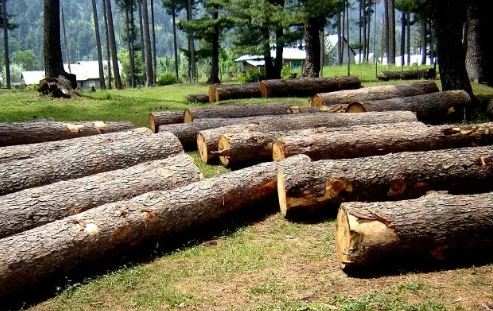PESHAWAR, OCT 19 (APP/DNA): Every morning, as the sun rises over the Grand Trunk (GT) Road between Peshawar’s Tarnab Farm and Azakhel in Nowshera, the haunting image of tree trunks lined up at roadside wood taals greets travelers, which is a painful reminder of the silent battle being waged against nature in Khyber Pakhtunkhwa.
Among those fueling this battle, knowingly or unknowingly, is Amanullah Khan, a father of three, who has run a saw machine near Pabbi Station for over a decade.
With calloused hands and sweat on his brow, he slices through the trunk of a shisham tree, its rings silently telling a story of decades lost in seconds.
As wood business get upward boom in start of winter season, Amanullah’s sons help bundle logs of neem, ber, amaltas, poplar and pulai native trees now vanishing fast in KP due to mushroom growth of marriages halls, tandoors and inadequate gas facilities.
“We get Rs800 to Rs1000 per 50kg of firewood in winter ,” Amanullah says, barely pausing. “In winter, tandoors and hotels pay even more. What choice do we have? Gas is expensive, and customers want cheaper fuel.”
But behind this daily hustle lies a much graver reality that the forests of Khyber Pakhtunkhwa are disappearing fast due to population explosion, socioeconomic imbalances and rise of wood taals business besides climate change.
The rampage deforestation exerted an extra pressure on wildlife habitats and bees population besides increased intensity of floods and desertification.
A visitor while travelling on Peshawar-Islamabad and Peshawar-DI Khan highway will be extremely disappointed to see hundreds of acres land swallowed by drought and desertification.
According to Pakistan’s National Forest Policy, nearly 27,000 hectares of private and community forests are lost every year nationwide.
The toll is heavier in Khyber Pakhtunkhwa and Gilgit-Baltistan, where communal and private lands such as shamalats and guzaras are under relentless pressure of deforestation.
The consequences of deforestation are severe, including declining agricultural productivity, reduced water flow in rivers, and frequent climate disasters as devastating floods in Buner and Swat districts in August this year.
Former conservator forests KP, Gulzar Rehman, draws a grim comparison and said, “Globally, about 10 million hectares of forests are lost every year. Half of that gets regrown. But here in Pakistan especially in KP, the loss is hardly ever recovered. If we don’t act now, our green cover, wildlife, and even pollinators like bees may vanish in the next few decades.”
In such grim scenarios, he said that the challenges to food security will aggravated and hunger viz a viz starvation would accelerated alarmingly keeping in view of rapid population explosion.
Pakistan’s population, which was just 37 million in 1947, has surged to over 243 million in 2025. The demands of this growing population—housing, firewood, agriculture—have intensified deforestation.
Adding to this burden is the legacy of hosting over four million Afghan refugees since 1979, many of whom relied on forest wood for survival, especially in tribal areas of Khyber Pakthunkhwa.
Swat, once a jewel of pine and deodar forests, now bears deep scars of unchecked logging. Wajid Ali, former Forest Minister, laments the ecological damage caused by what he calls “a legal loophole exploited by the timber mafia.”
“The decision to allow private forest owners to cut trees under the Woodlot Law made an adverse effects on forests. By the time the government intervened, vast stretches of forest in Swat, Shangla, Kohistan, and Chitral were already wiped out,” he claimed.
Despite the ban enforced under the KP Private Wood Lots Rules 2017, enforcement has been patchy. “While we chase political opponents in KP, the timber mafia thrives,” Wajid Ali claims, criticizing the KP CM’s PTI founder specific policy.
He also warns that thousands of trees planted under the Billion Tree Afforestation Project were cut prematurely by farmers, in violation of agreements signed with the Forest Department.
In response, KP’s Forest Department has ramped up enforcement. Forest Department authorities said that a specialized Forest Force, armed and empowered under the Forest Ordinance 2002, can now arrest and detain offenders, check vehicles, and even enter private premises to seize illegal timber.
“We have extended operations to merged tribal districts, with checkpoints on major highways to disrupt timber smuggling,” a department spokesperson said.
“We need special courts, better mobility, and community support to win this battle against deforestation.”
But despite these efforts, experts insist that law enforcement alone won’t be enough.
The scale of the problem demands urgent attention from Chief Minister Sohail Afridi as KP was highly vulnerable to climate change.
Climate experts, conservationists, and former government officials are calling for a “Green Emergency” that is a multi-pronged, province-wide initiative that combines strict enforcement with community participation, education, and promotion of alternative energy like solar and biomass.
Without such leadership and strict implementation of laws, the forests of KP from the valleys of Swat to the hills of Abbottabad and Chitral to Dobair Kohistan face a slow but silent extinction.
As Amanullah saw bites into another tree’s log, he is not thinking about biodiversity loss or melting glaciers. He’s thinking about feeding his family, paying school and doctor fees for survival.
But somewhere in the shadow of that sawdust-covered yard lies a difficult truth that saving the forests is not just the government’s job, but it is a shared responsibility by all the stakeholders to protect the green gold.
Without a shift in policy, awareness, improving local economies, job creation and priorities, the lush green heritage of Khyber Pakhtunkhwa may exist only in documentaries and photographs for future generations.
And when the last tree falls in KP, it won’t be the sound that haunts us but it will be our silence.
















